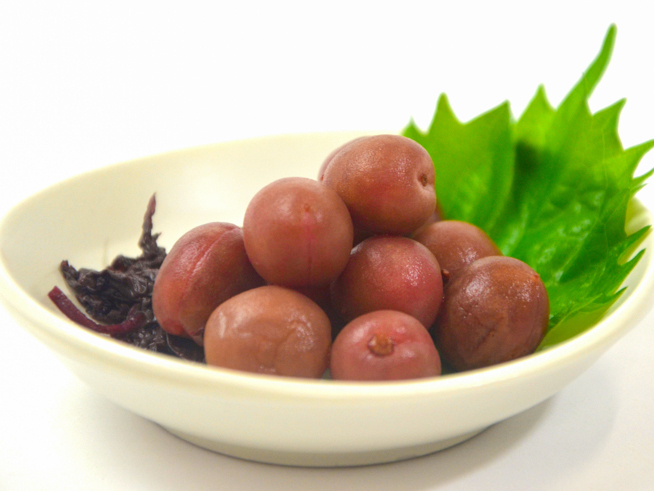
Koshu Ko-Umezuke Pickles

YamanashiKoshu Ko-Umezuke Pickles
Classification (Large)
Agricultural products
Classification (Small)
Pickled
Main ingredients used
Koshu koume, red perilla leaves, salt, vinegar
When using downloaded images, please read the "Terms of Use" and clearly state that the source of the image is "Traditional Foods in Japan" by the Ministry of Agriculture, Forestry and Fisheries.
If the photo credits is stated, please include it as well.
Example of description
of the photo credits
Example of description when the photo credits is not stated
Source: "Traditional Foods in Japan" Ministry of Agriculture, Forestry and Fisheries
Example of description when the photo credits is stated
Source: "Traditional Foods in Japan" Ministry of Agriculture, Forestry and Fisheries
Photo credits:xxx
Region of inheritance
Kofu City
Product overview (special characteristics and types)
Native small Japanese plums grown in Yamanashi Prefecture are collectively called Koshu koume (Koshu is the former name of Yamanashi Prefecture and koume means small Japanese plum, or ume, in Japanese). Many people associate Yamanashi with grapes and peaches, but the prefecture is also Japan’s top producer of koume. The Kofu basin gets a lot of sunshine during the day and gets cold at night. Since this specific climate is suitable for growing koume, the type grown here has a small seed and thick pulp, and tastes filling despite being 4 to 6 g.
Koshu koume is used to make a variety of processed foods, such as tsukeume, called Koshu koumezuke, and umeboshi, known as Koshu koumeboshi, as well as ume liquor, wine, and jam. Koshu koumezuke, which is a kind of pickled ume made by using unripe green ume, offers a texture that fully ripe ume does not have, and is also familiarly known as karikari koume. It is by far the most popular of the processed foods made of koume in the prefecture.
Karikari koume is made by pickling unripe green ume picked in early May. This is a bit earlier than for Koshu umeboshi and other processed foods of Koshu koume, which are made by using ume harvested around early June every year. The fabulous view of white ume flowers in preharvest ume groves is owed to the large number of flowers that the trees produce. In addition, each tree also bears a lot of fruit because they are self-fruitful.
History and culture
Yamanashi Prefecture, which is surrounded by mountains, is highly conscious of preserved food, and there is a record indicating that Koshu koume had already been a local specialty of the prefecture in the late Edo period. It is said that with the decline of the sericultural industry, the devastated mulberry fields were turned into ume fields and production of ume became more active.
Although ume production has been decreasing due to recent issues such as the current farmers getting older and residential land development, Yamanashi Prefecture is still Japan’s top producer of koume.
While conserving traditional sour and salty tsukeume and umeboshi, manufacturers occasionally review the tastes and textures of their products, lower the salt levels in response to rising health consciousness while maintaining quality, and make other improvements in tune with the times.
Production method
Koshu koumezuke:
Koshu koume harvested when it is still green is soaked in plenty of water to remove the harsh taste, hulled, and rubbed with salt until it becomes greener. Egg shells thoroughly washed and dried are roughly crushed in a bag, and then placed in the bottom of a container with the koume inside (to allow it to combine with the calcium contained in the egg shells to prevent the pectin in koume from softening it and to make it crunchy). A weight equivalent to the weight of the koume is placed on top, and it is left in a cool and dark place until white ume vinegar comes out. Red perilla leaves rubbed with salt to remove the harsh taste are added together with vinegar and shochu (distilled spirit), and the koume and other ingredients are given a few stirs and kept in the refrigerator. After about a month, the ingredients have soaked into the koume, which is then ready to eat.
By contrast, Koshu koumeboshi is made by using fully ripe Koshu koume. Egg shells are not used, but a drying process is added.
Conservation and succession efforts
Manufacturers develop their own elaborate products using Koshu koume, which are sold in stores and over the internet. In addition to standard tsukeume and umeboshi, they have been actively developing products adapted to the diversification of people’s food preferences and meal styles from new perspectives, ranging from wine and jam to products supplied in individual packages that you can carry with you and eat quickly as a snack.
Instant pickles, which are made by using soy sauce, kombu, dried bonito shavings, and other seasonings, are often made at home since they become ready to eat in two or three days and are easy to make.
Main consumption method
Koshu koumezuke is often put in box lunches, and its crunchy and crispy texture gives it a kick. It is not only eaten as is with white rice, but also considered suitable for making sweets because of its pleasant acidity, fruit-like sweetness, and especially its crunchy texture. There is even ganache containing chopped karikari koume.
At-home recipes:Koshu koume and cheese dressed with olive oil

Ingredients
Koshu koume
6 plums
Processed cheese
40 g
Extra virgin olive oil
As needed
Flower spikes of perilla
As needed
How to make
Cut Koshu koume into tiny pieces and cut processed cheese into 1-cm cubes.
Put the ingredients cut in 1 above in a bowl, add olive oil, and dress them with the oil.
Put them in a dish and garnish with flower spikes of perilla.

